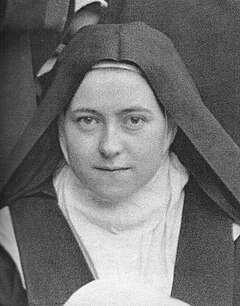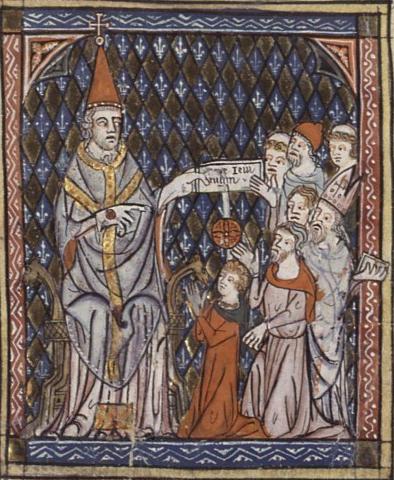Text from The Saint Andrew Daily Missal,
unless otherwise stated.
Saint Teresa.
Virgin.
Feast Day 15 October.
Double.
White Vestments.
Saint Teresa of Ávila (Saint Teresa of Jesus)
(1515-1582).
Illustration: UNA VOCE OF ORANGE COUNTY
Saint Teresa was born at Ávila, Spain. From her earliest childhood, she ardently desired to die a Martyr. At the age of eighteen, she entered The Order of Our Lady of Mount Carmel, and Consecrated herself to Christ, whom she chose for her spouse (Epistle).
[The Order of Mount Carmel, which spread over The East in Apostolic times, penetrated into The West in the 13th-Century. Illustrious Members of this Order, of much by their Sanctity, rank, or writings, are very numerous. Several have filled the greatest dignities in The Church.]
Her heart was so inflamed with Divine Love that she wrote: "How the enraptured Soul feels in this body its captivity and the misery of life ! It considers itself a slave sold in a foreign land; and, what is most bitter, is to see everywhere men's passionate love for this life, and so few banished ones who sigh like itself and Pray for the end of their exile." [Her autobiography, Chapter XXI.]

English: Saint Teresa Of Ávila (Saint Teresa Of Jesus).
One of the four female Doctors of The Church.
Deutsch: Hl. Therese von Avila.
Artist: Peter Paul Rubens (1577–1640).
Date: 1615.
Current location: Kunsthistorisches Museum, Vienna, Austria.
Source/Photographer: [1]
(Wikimedia Commons)
Counselled by Jesus, she made the difficult Vow of always doing what she judged most perfect.
She attained through Prayer the highest degree of Mystical Life, and there found such enlightenment concerning Divine things (Collect), that her works earned for her, from Popes Gregory XV and Urban VII, the august Title of Doctor of The Church, which has been given to no other woman.

Saint Catherine of Siena.
One of the four female Doctors of The Church.
The Church of Santa Maria del Rosario in Prati, Roma, Italy.
Author: Anonymous.
(Wikimedia Commons)
"The best Prayer," she wrote, "and the most pleasing to God, is that which brings on improvement, showing itself in good works, and not the enjoyment which only serves for our own satisfaction." [Letter to the Bishop of Ávila.]
The influence of this humble Virgin, who converted thousands of Souls, manifestly proves the supreme importance of The Contemplative Life, addressing itself, directly, as it does, to God, The Author of All Good.
She died of Divine Love on 5-15 October. 1582. [Pope Gregory XIII, in order to reform The Roman Calendar, had ordered the suppression of ten days of the year 1582; the day after 4 October was to be called the 15th of the same month. It was during this historic night, of the 4th to the 15th, that Saint Teresa died.]
Mass: Dilexísti.
Hildegard von Bingen's musical compositions.
Chant for The Feast of Saint Ursula.
Sung by Anonymous 4
Saint Hildegard von Bingen is one of the
four female Doctors of The Church.
Available on YouTube at

Saint Thérèse of Lisieux.
One of the four female Doctors of The Church.
English: Detail of Saint Therese of the Child Jesus
in the photograph taken in the courtyard of the
Monastery of Lisieux, Easter Monday, 15 April 1894.
Español: Detalle de Santa Teresa del Niño Jesús en la fotografía tomada en
el patio del monasterio de Lisieux el Lunes de Pascua, 15 de abril de 1894.
Français: Détail de Sainte Thérèse de l'Enfant Jésus dans la photographie
prise dans la cour du monastère de Lisieux lundi de Pâques, 15 Avril, 1894.
Italiano: Particolare di Santa Teresa del Bambino Gesù nella fotografia
scattata nel cortile del monastero di Lisieux Lunedi di Pasqua, April 15, 1894.
Date: 3 September 2014.
Source:
Archivos del Carmelo de Lisieux.
Author:
Celine Martin (Sor Genoveva de la Santa Faz).
(Wikimedia Commons)
Teresa of Ávila, also called Saint Teresa of Jesus, baptised as Teresa Sánchez de Cepeda y Ahumada (28 March 1515 – 4 October 1582), was a prominent Spanish Mystic, Roman Catholic Saint, Carmelite Nun, author during The Counter Reformation, and Theologian of Contemplative Life through Mental Prayer. She was a Reformer of The Carmelite Order and is considered to be a Founder of The Discalced Carmelites along with John of The Cross.
In 1622, forty years after her death, she was Canonised by Pope Gregory XV, and, on 27 September 1970, was named a Doctor of The Church by Pope Paul VI. Her books, which include her autobiography (The Life of Teresa of Jesus) and her seminal work El Castillo Interior (The Interior Castle), are an integral part of Spanish Renaissance literature as well as Christian Mysticism and Christian Meditation practices. She also wrote Camino de Perfección (The Way of Perfection).
After her death, Saint Teresa's cult was known in Spain during the 1620s, and for a time she was considered a candidate to become a National Patron Saint. A Santero image of Our Lady of The Conception, said to have been sent by Saint Teresa with one of her brothers to Nicaragua, is now Venerated as the Country's National Patroness at The Shrine of El Viejo. Pious Catholic beliefs also associate Saint Teresa with the esteemed religious image called Infant Jesus of Prague, with claims of former ownership and devotion.

THE SAINT ANDREW DAILY MISSAL
THE SAINT ANDREW DAILY MISSAL
Available (in U.K.) from
Available (in U.S.A.) from









.jpg)
%252B(2).jpg&container=blogger&gadget=a&rewriteMime=image%2F*)
-35.jpg)












